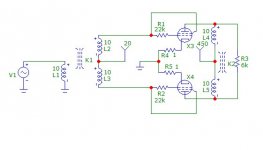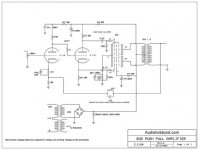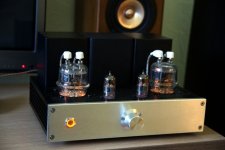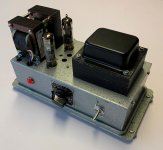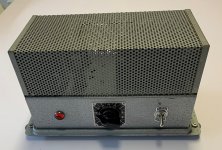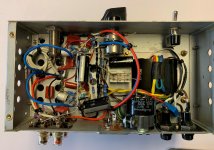That is a very nice design Mr. Stewart! That cathode biasing on the second tube puzzle me: why did you do the bias adjusting this way? Is there a specific reason for that? If I am correctly interpreting it of course.
Thankyou Joe. Normal Cathode Bias is developed across the 270R resister R8. I've used the 14V developed to elevate the other tube heaters above their cathodes. This is usually done when there is a low level stage on the front end of an amplifier such as this one. It helps to minimize any heater to cathode leakage & resultant hum injected into the signal.
The 50R Potentiometer P1is a further hum rejection circuit, adjustable for best hum rejection. With care all this eliminates the requirement for a DC heater supply. None of the parts in this project are specially selected. All of the parts are commonly available, off the shelf.🙂
Here it is in toobz.🙂
AB2 with input transformer can be simpler than that... Cathode resistors only required for "no specs" tubes to get the bias right.
Attachments
Hi Chris...I have only one audio system. That combines a heavily modified CD Player, Home built DHT pre (parafeed), home built 300B se with choke loaded driver and modified Fostex 206 in Fostex recommended 208 sigma cab.
I still enjoy music through radios. I strongly believe for enjoying music you don't need hifi.
Regards
Regards
I still enjoy music through radios. I strongly believe for enjoying music you don't need hifi.
Regards
Regards
I'm the opposite. I can not listen to music through a phone speaker for instance. The only music that sounds good Lo-Fi was stuff recorded on at 78 IMHO like Artie Shaw.
Hi Joe,
Just make sure you have enough room for musical peaks, that's all. I would work back from your speakers to see how much power you really need as tubemax suggested.
I have tube amps that I use, and am designing one. I get where you are coming from and agree you should proceed with the little tube amp project. My example was over the top for most people, and I just had the opportunity, that's all.
-Chris
Just make sure you have enough room for musical peaks, that's all. I would work back from your speakers to see how much power you really need as tubemax suggested.
I have tube amps that I use, and am designing one. I get where you are coming from and agree you should proceed with the little tube amp project. My example was over the top for most people, and I just had the opportunity, that's all.
-Chris
lose the input transformer in favor of a concertina splitter ksc1845 works great at lower voltages.
At This Age
Anything sounds good.😀 But my daily driver in the office is a Sansui TU717/AU717 combo. Never been cranked to the max on Artie Shaw or anyone else.🙂
Anything sounds good.😀 But my daily driver in the office is a Sansui TU717/AU717 combo. Never been cranked to the max on Artie Shaw or anyone else.🙂
Koda, 78's sound much better with high resolution equipment!
If the highest frequency on the record is 8kHz, it will sound fine on AM radio. No need for hi-res... or are you talking about upsampling and digital f*ckery?
Koda, 8kHz is the limit in most(but not all) pre-war 78's. By the end of the war the major companies were up to 20 kHz. Late HMV and Decca 78's are much higher fidelity than early LP's. All 78's are more demanding of the turntable and particularly the arm than LP's.
Hi minhaj,
Well, you're talking about a choice here. That's perfectly fair for you and many others. However, many of us really do enjoy something a little better.
For what you are doing, your choices are perfectly valid. But I think there is room in this world for life above a watt or two. Same for lower distortion, you will just accept a higher level than many would find acceptable.
Hi kodabmx,
Don't confuse resolution with frequency response. Having 78's myself (and actively limiting the highs), they do sound better on a high resolution system than one that struggles with distortion and noise. While they sound okay through a system that does AM reception, they are much better using a mono 78 cartridge on a good system.
Of course, that is only my opinion.
-Chris
Well, you're talking about a choice here. That's perfectly fair for you and many others. However, many of us really do enjoy something a little better.
For what you are doing, your choices are perfectly valid. But I think there is room in this world for life above a watt or two. Same for lower distortion, you will just accept a higher level than many would find acceptable.
Hi kodabmx,
Don't confuse resolution with frequency response. Having 78's myself (and actively limiting the highs), they do sound better on a high resolution system than one that struggles with distortion and noise. While they sound okay through a system that does AM reception, they are much better using a mono 78 cartridge on a good system.
Of course, that is only my opinion.
-Chris
Koda, 8kHz is the limit in most(but not all) pre-war 78's. By the end of the war the major companies were up to 20 kHz. Late HMV and Decca 78's are much higher fidelity than early LP's. All 78's are more demanding of the turntable and particularly the arm than LP's.
Fair point. My newest 78's are from the 50's but most are from the 30's and 40's. I added 78 to my turntable (10 cents for a resistor and 2 inches of wire), and use a Stanton 500 with ~5g or force.
Summing L+R eliminates the common mode noise the from record, too. Even with the CM noise, I'm impressed at the fidelity of a record that's older than my father. I don't cut highs, either. I have no tone controls, but when I sample it and mess with it digitally, I'll usually boost the highs a bit.
Hi kodabmx,
Don't confuse resolution with frequency response. Having 78's myself (and actively limiting the highs), they do sound better on a high resolution system than one that struggles with distortion and noise. While they sound okay through a system that does AM reception, they are much better using a mono 78 cartridge on a good system.
Of course, that is only my opinion.
-Chris
You have a great point of course.
I'm just saying when I hear 20-20kHz Artie Shaw remastered or modern big band, it sounds strange with HF and stereo 🙂
I can't listen to AM radio here anyway. The entire band is 60Hz hum like you're under a bridge near power lines.
I've never used a mono cart though. It's just easier to get a D5127 or the like for the Stanton 🙂
A copy of my oldest record - recorded on an old trash Technics TT with an Ortofon OM78 - summed to mono by software.
a - 2091 - Irving Kaufman - There's a little bad in every good little girl by k0d4 | Free Listening on SoundCloud
And a better copy found on YT There's A Little Bit Of Bad In Every Good Little Girl by Irving Kaufman - YouTube
Last edited:
A phone/tablet speaker is the worst abomination on the planet. I’d rather have no speaker at all. An old 1970’s model table radio sounds better - at least I *can* listen to music on one of those. If someone is playing music or a video on a tablet I leave the room if possible.
Hi kodabmx,
You have got to try a mono cartridge! It's different. When you get the chance of course, because no stereo cartridge is perfectly matched L to R. The summation isn't nearly as good as it can be.
I completely agree with you on the 78's converted to files or CD as they often are not using a mono cartridge to do so. I have a Sparton 78 record player (no radio) that I am going to restore. It's a tube unit, P-P outputs with a speaker built in. I am really looking forward to this piece of furniture.
-Chris
You have got to try a mono cartridge! It's different. When you get the chance of course, because no stereo cartridge is perfectly matched L to R. The summation isn't nearly as good as it can be.
I completely agree with you on the 78's converted to files or CD as they often are not using a mono cartridge to do so. I have a Sparton 78 record player (no radio) that I am going to restore. It's a tube unit, P-P outputs with a speaker built in. I am really looking forward to this piece of furniture.
-Chris
If you need to deliver much more than 7watts from a valve amp it quickly gets big and expensive. This is why starting from inefficient crossover dominated old speakers from the era of big box transistor amps is the wrong approach to a small good sounding bedroom setup. So its right to start at the speakers but its wrong to try to shoehorn your design to work with unsuitable candidates.
Shoog
Shoog
Unfortunately the author 's website has not been working for some time ... I have only scematic in the archive in poor resolution. Very compact and pleasant-sounding amplifier - approx. 7W. A slightly more "massive" power supply in my build with russian tubes - 6n23p and gu32.
Attachments
You are welcome.
Check out the PM, I sent you. DiyAudio member- Bennybuis,made some interesting posts.
Check out the PM, I sent you. DiyAudio member- Bennybuis,made some interesting posts.
I followed the jhstewart9 advice at post #30 and yesterday I've built the single-ended ECL86 / 6GW8 Telefunken reference design I attached to post #54, reusing a nice vintage small chassis I had around and Edcor GXSE-10-6-8K output transformers (10w, 8k primary, 6 ohm secundary because my speakers are 6 ohm). I only listened to it a few hours, but I believe to have found a worthy replacement for my Lingwendil 6SN7 push-pull flea amplifier. If somenone want to try by itself, here are my quick build notes:
- I had to lower to 47 ohm the feedback resistor between the negative terminal of the volume potentiometer and ground. With the original 110 ohm resistor and 6 ohm speaker, the amplifier was motorboating at low volume. I will maybe try 82 ohms later.
- Removed the RC network (10nF 51k) from the extra tap of the (vintage) volume control. Too much attenuation of high frequency. It may be possible to use a modern standard potentiometer.
- catode capacitor is now a Kemet 560uF 25V Aluminum Organic Polymer. Cathode resistor is two 330 ohm 1W resistors in parallel (165 ohms).
- instead of the single 2.5k resistor on G2, I used two 1.2K 1W resistors in series.
- I had to swap around the Edcor secundary windings (purple to ground, white to positive terminal).
- I removed the 300pF capacitor in parallel to the output transformer primary.
- The output transformer wire connected at the pentode anode must be routed as far away as possible from the components connected to grids, or oscillation may occour. The 1K grid stopper is essential.
- With 280V supply, voltage at the output pentode cathode is 7V. Dissipation is right at the datasheet limit.
- Some ECL tubes don't like the grid leak polarization and are noisy. Most tubes works perfectly fine without any noise (I tried about 20 tubes, NOS and used). I am currently using 6GW8 Fivre tubes (RCA licensee).
- I was forced by the small chassis (23cm / 9 inches wide) to place output transformers close to the power transformer, so there is very faint 50Hz hum due to magnetic coupling. On ECL86 Mullard/Philips circuit, when the tubes start working the hum disappears due to the high global feedback action. It was counting on it, but it does not happens on this circuit. I will maybe try to replace the power transformer with a shielded one, or add a copper belt around it.
- There is no need to attenuate a modern 2V source, input level is fine.
I have not done measurements yet: the amplifier has ben built according to the schematic, so the Telefunken performance statements should be true. The sound does remind - unsurprisingly - a high quality german tube radio from this era. The frequency response does have a slight bass boost while highs are attenuated just a bit. This works exceptionally well at low to medium volume, but the power is enough for the occasional musical peak without noticeable clipping. Nice vintage sound, I like it. By the way, due to the low parts count and uncritical circuit, this is a true weekend build.
- I had to lower to 47 ohm the feedback resistor between the negative terminal of the volume potentiometer and ground. With the original 110 ohm resistor and 6 ohm speaker, the amplifier was motorboating at low volume. I will maybe try 82 ohms later.
- Removed the RC network (10nF 51k) from the extra tap of the (vintage) volume control. Too much attenuation of high frequency. It may be possible to use a modern standard potentiometer.
- catode capacitor is now a Kemet 560uF 25V Aluminum Organic Polymer. Cathode resistor is two 330 ohm 1W resistors in parallel (165 ohms).
- instead of the single 2.5k resistor on G2, I used two 1.2K 1W resistors in series.
- I had to swap around the Edcor secundary windings (purple to ground, white to positive terminal).
- I removed the 300pF capacitor in parallel to the output transformer primary.
- The output transformer wire connected at the pentode anode must be routed as far away as possible from the components connected to grids, or oscillation may occour. The 1K grid stopper is essential.
- With 280V supply, voltage at the output pentode cathode is 7V. Dissipation is right at the datasheet limit.
- Some ECL tubes don't like the grid leak polarization and are noisy. Most tubes works perfectly fine without any noise (I tried about 20 tubes, NOS and used). I am currently using 6GW8 Fivre tubes (RCA licensee).
- I was forced by the small chassis (23cm / 9 inches wide) to place output transformers close to the power transformer, so there is very faint 50Hz hum due to magnetic coupling. On ECL86 Mullard/Philips circuit, when the tubes start working the hum disappears due to the high global feedback action. It was counting on it, but it does not happens on this circuit. I will maybe try to replace the power transformer with a shielded one, or add a copper belt around it.
- There is no need to attenuate a modern 2V source, input level is fine.
I have not done measurements yet: the amplifier has ben built according to the schematic, so the Telefunken performance statements should be true. The sound does remind - unsurprisingly - a high quality german tube radio from this era. The frequency response does have a slight bass boost while highs are attenuated just a bit. This works exceptionally well at low to medium volume, but the power is enough for the occasional musical peak without noticeable clipping. Nice vintage sound, I like it. By the way, due to the low parts count and uncritical circuit, this is a true weekend build.
Attachments
- Home
- Amplifiers
- Tubes / Valves
- low power bedroom amp
